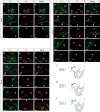Myocardium-derived angiopoietin-1 is essential for coronary vein formation in the developing heart
- PMID: 25072663
- PMCID: PMC4124867
- DOI: 10.1038/ncomms5552
Myocardium-derived angiopoietin-1 is essential for coronary vein formation in the developing heart
Abstract
The origin and developmental mechanisms underlying coronary vessels are not fully elucidated. Here we show that myocardium-derived angiopoietin-1 (Ang1) is essential for coronary vein formation in the developing heart. Cardiomyocyte-specific Ang1 deletion results in defective formation of the subepicardial coronary veins, but had no significant effect on the formation of intramyocardial coronary arteries. The endothelial cells (ECs) of the sinus venosus (SV) are heterogeneous population, composed of APJ-positive and APJ-negative ECs. Among these, the APJ-negative ECs migrate from the SV into the atrial and ventricular myocardium in Ang1-dependent manner. In addition, Ang1 may positively regulate venous differentiation of the subepicardial APJ-negative ECs in the heart. Consistently, in vitro experiments show that Ang1 indeed promotes venous differentiation of the immature ECs. Collectively, our results indicate that myocardial Ang1 positively regulates coronary vein formation presumably by promoting the proliferation, migration and differentiation of immature ECs derived from the SV.
Figures









References
-
- Luttun A. & Carmeliet P. De novo vasculogenesis in the heart. Cardiovasc. Res. 58, 378–389 (2003). - PubMed
-
- Riley P. R. & Smart N. Vascularizing the heart. Cardiovasc. Res. 91, 260–268 (2011). - PubMed
-
- Del Monte G. & Harvey R. P. An endothelial contribution to coronary vessels. Cell 151, 932–934 (2012). - PubMed
-
- Guadix J. A., Carmona R., Munoz-Chapuli R. & Perez-Pomares J. M. In vivo and in vitro analysis of the vasculogenic potential of avian proepicardial and epicardial cells. Dev. Dyn. 235, 1014–1026 (2006). - PubMed
Publication types
MeSH terms
Substances
LinkOut - more resources
Full Text Sources
Other Literature Sources
Molecular Biology Databases
Miscellaneous

